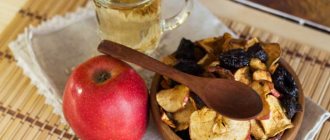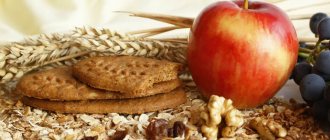All iLive content is reviewed by medical experts to ensure it is as accurate and factual as possible.
We have strict sourcing guidelines and only link to reputable sites, academic research institutions and, where possible, proven medical studies. Please note that the numbers in parentheses ([1], [2], etc.) are clickable links to such studies.
If you believe that any of our content is inaccurate, out of date, or otherwise questionable, please select it and press Ctrl + Enter.
A nursing mother has to be responsible about her diet, because... everything, both good and bad, enters the baby’s body with milk. Caring mothers are interested in eating healthy, healthy, nutritious and varied. The most common foods can sometimes cause colic, digestive disorders, and allergic reactions in a child. To help women, special tables have been compiled that provide an approximate menu indicating at what age the child can eat what the mother can eat. [1]
What can a nursing mother eat in the first months of her baby?
It makes no sense to tie a woman only to certain products, but defining the basis, focusing on safety and quality of nutrition is the task of pediatricians.
The first month of breastfeeding is an important period in the baby’s life and the mother will help him adapt by consuming:
- porridge with water or low-fat milk (buckwheat, oatmeal, rarely wheat);
- one chicken or 2-3 boiled quail eggs every three days;
- dietary meats (rabbit, poultry, veal);
- low-fat cottage cheese, kefir, homemade yogurt;
- boiled and steamed vegetables in the first week, then carefully raw, in small portions, keeping an eye on the child’s reaction;
- Vegetable oils include olive, sunflower, and corn (15 ml per day);
- up to 35g butter;
- occasionally durum pasta;
- fish in the third week, prepared using the dietary method;
- first lenten dishes;
- fruits: baked apples, bananas;
- drink water, dried fruit compote, apple juice;
- dessert made from homemade fruit marshmallows and the same marshmallows.
The second and third months are supplemented by:
- sour cream;
- borscht in a weak broth, seasoned with tomato juice;
- raw fruits and vegetables;
- corn grits, rice;
- nuts in small quantities, except pistachios and peanuts;
- fruit drinks from cherries, blueberries, currants, lingonberries.
The frequency of meals should be 5-6 times a day, so the question arises, what can a nursing mother eat in the evening and at night to satisfy hunger, but not gain weight? You can have dinner with boiled vegetables, soups, salads made from them, fish [2] and lean meats, steamed, washed down with weakly brewed green tea with crackers or bread. At night, it is best to drink a glass of kefir.
Irregular bowel movements are a common problem in the postpartum period. To avoid constipation, a woman should give preference to cereals, raw vegetables, and drinking plenty of fluids, including juices, fruit drinks, compotes, but not dried fruits.
In the third or fourth month
The menu of a nursing mother becomes a little richer at 3 months.
You can add nuts to it (walnuts, pine, almonds, peanuts and pistachios are not recommended), starting with a quarter of a kernel or one small grain. The daily norm is about 2-3 kernels for walnuts. You need to be careful with them, as nuts often cause allergies. After 3 months, children usually go through a period of colic, so the mother can feel more free at the table, because her baby’s gastrointestinal tract has finally more or less adapted to the new life. Now his body is stronger, so reactions to new foods are likely to be much weaker.
The nutrition of a nursing mother at 3 months may look something like this:
- You can include in the menu: freshly squeezed juices and fruit drinks (from pumpkin, apples, beets or carrots) - no more than a glass a day;
- pearl barley and wheat porridge;
- fresh onions in small quantities;
- tomatoes and cucumbers from your garden;
- boiled vegetables (beets, pumpkin, carrots).
- meat broths;
At 4 months, the diet does not undergo significant changes. Mom continues to gradually introduce permitted foods:
- You can add to the menu: fried meat - no more than once a week;
- corn, rice porridge;
- chicken meat;
- baked meat (the main thing is not to overdo it with browning);
- some spices – not the hottest and spicy ones;
- some mild dressings, for example, sour cream sauce, tomato for borscht;
- the range of juices and compotes is expanding, also 1 glass per day, observing the child’s reaction;
- chocolate, cocoa;
If you really want something citrusy, your body may not have enough vitamin C. In this case, you can find a safe substitute for oranges and lemons, for example, rosehip infusion.
What can a nursing mother of a premature baby eat?
By international standards, a child born at up to 37 weeks is considered premature, and a viable one - from 22 weeks. They are nursed in incubators - special incubators where a microclimate close to the mother's womb is maintained. First they feed with a tube, then, when the sucking and swallowing reflex appears, they add feeding from a spoon, cup, and then breastfeeding. If the child does not take it, then the woman expresses the milk, which the baby receives through the nipple from the bottle. In any case, the mother’s food should be rich in vitamins B1, B2, B6, B12, folic acid, microelements: iron, iodine, zinc. Special juices enriched with them have been developed, from where they enter the body in an easily digestible form. Infusions of herbs such as fennel, lemon balm, anise, and caraway will also help. [3]
Dish recipes
Despite the restrictions on cooking methods, you can prepare an appetizing and varied menu from the list of permitted products given above. Here are some recipes.
- add chopped carrots, potatoes, zucchini to a weak chicken broth, add a piece of butter, bring to readiness, chop dill, parsley;
- boil cauliflower, broccoli, zucchini, puree everything in a blender, and season with melted butter before serving;
- Cut the potatoes into the vegetable broth, shortly before removing from the heat, throw in the vermicelli, pour in the broken egg and a little butter, stirring.
- make minced meat from dietary meat, add boiled rice, chopped onions, a couple of spoons of sour cream. After kneading, form meatballs and steam;
- Cut the zucchini lengthwise into 2 halves and scoop them out. Lightly simmer strips of chicken fillet in a frying pan with the addition of vegetable pulp. Stuff the zucchini with them, sprinkle with grated low-fat cheese, bake in the oven;
- Place sea fish in several layers in a pan, topping them with onion half rings, slices of carrots, beets, tomatoes, and your favorite mild seasonings. Pour in a small amount of water and keep it on low heat after boiling until the ingredients are completely cooked.
- combine cottage cheese, a little sugar, a chicken egg, 2 tablespoons of semolina pre-filled with sour cream, mix well, place in a slow cooker and bake:
- cut off the tops of the apples and make indentations in them, fill with pre-prepared curd mass, bake;
- Place fruits (pears, apples, pitted apricots) individually or together in a saucepan, add water (a glass of liquid per kilogram) and cook over low heat until thickened, then spread the mass in a thin layer on oiled parchment paper on a baking sheet and keep in the oven 50-60 minutes. After the resulting marshmallow has cooled, cut the layer into strips and roll it up like a snail for aesthetics.
What determines the quality of breast milk?
Not only the foods and dishes allowed during breastfeeding influence, but also the state of the woman’s nervous system and her lifestyle. For obvious reasons, a young mother cannot help but be nervous, but she is within her power to build her own daily routine. It is recommended to devote more time to rest: the more time a woman allows herself to sleep and refuse to perform heavy household duties, the better she feels. And her good health is the key to the health of the baby, who will receive all the necessary substances from the breast milk of a calm and well-rested mother. So you can safely involve your husband in your household responsibilities (yes, he works, but motherhood is also hard work, which, by the way, is not paid), relatives, friends, or hired nannies and cleaners. A woman cannot feed normally if she does not have the opportunity to simply get enough sleep and do other things (we are not talking about cleaning and cooking, but about hobbies and cultural leisure).
What should a nursing mother not eat?
Sometimes nursing mothers fall short of a healthy and well-thought-out diet, but they still absolutely must not eat:
- products containing preservatives and dyes;
- mayonnaise and other hot sauces;
- fast food, semi-finished products, sausages;
- canned food, pickles, smoked meats;
- carbonated drinks. [4]
Restrictions on food are not a whim during the period of breastfeeding, but are prerequisites for the child’s good health, strong immunity, and good mental abilities.
For some, sticking to a diet while breastfeeding seems very difficult, but it is only difficult for the first time after childbirth, when the nursing mother has to get used to the new regime, monitor the baby’s reaction, his state of health, in order to understand which foods are acceptable and which are not. there is in the first month. Following a diet is necessary to maintain lactation for as long as possible. In addition to proper, balanced nutrition, it is equally important to drink plenty of fluids. It is worth taking into account the advice from the maternity hospital, adding personal experience and observations of the response of your baby’s body, and then the young mother will be able to easily raise her child healthy and instill in him the right eating habits.
Recommendations for nursing mothers do not differ significantly from the rules of healthy eating for an ordinary person.
How to properly introduce foods into the diet of a nursing mother
Graduality, caution and observation are the three main principles that a mother should follow when introducing new foods into her diet during lactation. A food diary is very helpful, where all new foods and the child’s reaction to them are recorded.
You need to introduce new dishes to the menu for every day strictly in turn - no more than one every 2-3 days. This will allow you to determine exactly what the baby’s reaction was. They start with the least dangerous foods in terms of allergies, timing the “new product” with the morning meal. The first time you need to eat a very small portion, carefully monitoring the child’s reaction over the next 2-3 days.
Read our article for details about permitted foods during breastfeeding and the rules for their introduction into the mother’s diet.
The menu for a nursing mother according to Komarovsky is more free than the official strict recommendations. The famous doctor believes that mom can eat whatever she wants, but be sure to observe moderation and monitor the baby’s reaction. However, he recommends excluding the following products from the menu:
- herbs and spices (including onions, garlic);
- semi-finished products, fast food, soda;
- smoked meats, pickles, marinades, sausages;
- exotic vegetables and fruits;
- dressings and sauces - mayonnaise, adjika, ketchup, etc.;
- condensed milk, products with a high content of dyes, flavors and preservatives;
- pasta (lots of it).
The doctor is confident that the list of healthy approved foods allows the mother to eat a varied and tasty diet without causing harm to herself or the baby.
Proper nutrition for a nursing mother is the key to the health and full development of the baby, as well as the basis for its well-being in the future. Of course, the health of an adult is largely influenced by his lifestyle, but it is the period of breastfeeding that lays the foundations for immunity, mental development, and a tendency to allergic reactions.
Therefore, many pediatricians recommend adhering to the nutritional table for a nursing mother by month, especially in the first six months. It will minimize the risk of developing allergies and the entry of various toxins and other harmful substances into the baby’s body.
Read about a hypoallergenic diet for breastfeeding.
This table shows products recommended and not recommended by pediatricians for breastfeeding. Read below about which food from the permitted list to introduce in which month.
Basic nutritional recommendations during lactation
Today, many pediatricians recommend feeding a newborn baby on demand. This means that there are no strict intervals between feedings and no specific serving size; they will be individual for each baby. Accordingly, every mother should eat differently, but there are general nutritional recommendations that all breastfeeding women should follow. And this:
- It is desirable that a nursing woman’s diet consist of cereals (buckwheat, oatmeal), potatoes, pasta, wholemeal products containing large quantities of complex carbohydrates that satisfy hunger for a long time and do not harm the figure;
- The nutrition of every mother during breastfeeding, especially in the first weeks, should be complete. Vegetables and fruits rich in fiber should be consumed, both raw and processed. In addition, to the main dishes it is worth adding dairy and fermented milk products (milk, kefir, cottage cheese), which contain the protein necessary for the body;
- in addition to variety, a woman’s diet during breastfeeding should be nutritious; eat meat products daily - lean meats, poultry (preferably turkey);
- consume both vegetable and animal fats (for example, butter and olive oil) in small portions;
- From time to time, the menu should include fish, preferably sea varieties. This is a source of iodine for the body, as well as omega 3 acids;
- It is recommended to add any new product to the mother’s diet gradually, carefully monitoring the baby’s reaction, since the baby may have an allergic reaction to many foods (in this case, some of them will have to be abandoned).
These recommendations do not differ significantly from the rules of healthy eating for an ordinary person. Foods should be consumed fresh, natural, it is better to eat often and in small portions, and the diet during breastfeeding will be supplemented by consuming sufficient amounts of fluid to increase lactation.
Diet for breastfeeding women after caesarean section
After surgery, the body requires support for intensive recovery. On the first day after surgery, it is necessary to monitor not only the reproductive and genitourinary systems, but also the functioning of the digestive tract. Doctors give recommendations on nutrition and drinking regime for each woman in labor.
Taking into account the peculiarities in the development of lactation, the menu is compiled not only from products that are safe for mother and child, but also those that stimulate the production of milk:
- fermented milk products - yoghurts, fermented baked milk and kefir (preferably bio-kefir) can be consumed half a liter per day, make casseroles;
- lean meat (poultry and beef) strictly steamed or boiled (can be boiled in pieces or made into cutlets), fried is not allowed;
- cottage cheese with a low fat content;
- fruits and vegetables except those that stimulate increased gas formation;
- butter and vegetable oils in small doses.
It is important to prevent hunger and thirst in order to avoid exhaustion of an already weakened body. The food should be varied; following the doctor’s recommendations, you can add other foods.
On the first day after cesarean section, all solid food is excluded.
It is allowed to drink non-carbonated mineral water, juice or compote without sugar. Main nutrition occurs intravenously
. After a few days, the menu expands and the consumption of cereals, broths and boiled chicken is allowed.
What is allowed and what is not to eat in the first month of the Guards
Allowed
Forbidden
White fish (pollock, boiled or baked cod)
Hard cheeses, low-fat cottage cheese, sour cream
Green apples, pears, bananas
Cucumbers, cauliflower, broccoli, potatoes, zucchini, carrots
Chocolate with high cocoa content, marshmallows, marshmallows, oatmeal cookies, bran bread
Rice, buckwheat, oatmeal, corn porridge without milk, durum wheat pasta
Vegetable oil, butter
Smoked mackerel, salted herring, seafood, canned fish
Processed cheese, products with fillings, cream, glazed sweet cheeses
Citrus, exotic fruits
Onion, garlic, horseradish, white cabbage, bell pepper, basil
Sweet, rich pastries, ice cream with fillings, glaze, milk chocolate, white bread, jam, marmalade
Semolina, egg noodles
Mayonnaise, ketchup, mustard, sauces, seasonings
Through mother's milk, the baby absorbs all the ingredients that the mother consumes. Therefore, you need to eat dishes that are healthy for mother and baby in order to eliminate possible manifestations of allergies and intestinal colic in the baby. A proper, balanced diet also affects milk production; some foods will increase lactation, others will decrease it. You should also avoid eating foods that can change the taste of milk, otherwise the baby may be capricious and completely refuse to latch on to the breast.
Every mother's nutrition when breastfeeding should be complete.
Definitely no
Modern researchers confirm the connection between a mother's diet and the quality of breast milk. This means that we can safely say that a nursing mother’s diet should consist of foods that are healthy for her! On the contrary, you should avoid, or even completely abandon, the consumption of foods that:
- increase the load on the gastrointestinal tract, liver, pancreas, and also increase the likelihood of excess weight (this can be fatty, fried and “heavy” foods, canned foods);
- have a negative (currently) effect on a woman’s central nervous system (disinhibiting effect), for example, strong tea (black, green) and coffee;
- contain preservatives, dyes and stabilizers that can affect the hormonal system of a nursing woman, at a time when she is in the process of recovering from childbirth and is most vulnerable.
What can a nursing mother eat in the first month after giving birth?
A nursing woman should eat not only healthy, but also tasty. In the first half of the day you can eat more high-calorie foods. A sample menu for 1 day looks like this:
Breakfast : porridge, a piece of bread with cheese, green tea.
Second breakfast : oven-baked cheesecakes or cottage cheese casserole, fruit.
Lunch : chicken soup, boiled meat, durum pasta on the side, dried fruit compote.
Afternoon snack : kefir with oatmeal cookies, fruit.
Dinner : baked vegetables, meat.
Late dinner : fermented baked milk.
Basic principles of nutrition after childbirth
The postpartum diet is not aimed at losing weight; it should not be too tough and debilitating. It is best to contact a specialist to draw up a nutrition plan, because the diet must be selected individually
for each mother and based on the state of the immune system, microflora and the presence of any allergies.
All mono-diets
, food should be
varied
. When following a diet, every mother should adhere to several principles.
The human body is susceptible to diseases and prone to the development of various pathologies, one of which is nodes on the thyroid gland. Large nodular neoplasms are dangerous because they cause hormonal imbalance, negatively affect the functioning of the cardiovascular and reproductive systems, and can also provoke cancer. Read more in the article: “nodules on the thyroid gland.”
No need to eat for two
This is the most common mistake among young mothers. In this situation, the decisive factor is quality, not quantity; the new mother does not need to eat twice as much. Even in a normal, non-pregnant state, overeating is fraught with poor health and severe stress on the digestive system.
Milk should not be “empty”, but also not oversaturated, because this will put a strain on the child’s gastrointestinal tract, and some foods consumed in large quantities can cause allergies, colic and bloating in the baby.
Food diary
To systematize food intake and track the baby’s reaction to certain foods, it is recommended that every mother keep a food diary. It needs to be maintained regularly and all foods introduced into the diet must be included. Its pages look like this:
| Product introduction date | The product's name | Child's chair | Skin | General condition of the baby |
| The new product is tried in the first half of the day in small quantities. After two days, the child’s reaction is monitored. | Everything unusual is noted: the presence of greenness and yellowness, consistency, sliminess, color and multiplicity. | Presence of rash, irritation. | Moodiness, sleep state, temperature, gastrointestinal tract function (colic, bloating, diarrhea, vomiting). |
Products should be introduced gradually and all changes in the child’s well-being should be recorded in a diary. If there are people in the family who suffer from allergies or the mother herself is allergic, you need to use new products with extreme caution.
Templates for food diaries can be found on the Internet or drawn out in a notebook yourself.
Stop products
The list of products that a woman consumes during lactation may vary depending on the age of the child and the duration of breastfeeding. But doctors recommend removing some foods from the diet for the entire period of breastfeeding. Doctors give a list of them upon discharge; the list of prohibited ones almost always includes:
- canned meat, dairy and fish;
- pickles (store-bought and homemade);
- ketchup and mayonnaise;
- vegetable marinades;
- semi-finished products;
- whole cow's milk;
- hot and spicy sauces, soy sauce is possible;
- legumes (can only be used in very small quantities, as they are a gas-forming product and may cause the child to swell);
- strong coffee (it’s better to remove it altogether) and tea;
- packaged juices;
- alcohol;
- nuts;
- grape;
- White cabbage;
- chocolate;
- processed cheeses and blue cheese;
- sausage products.
Dishes containing these products can cause bloating and colic in your baby. Mother's milk, which contains impurities and elements of these foods, has an irritating effect on the baby's unadapted stomach. So that the child does not become capricious and sleep peacefully, it is better not to eat this food.
[media=
https://youtu.be/HXTLJMnKU1c
]
Possible dangers of non-compliance with the diet
When a baby feeds exclusively on breast milk, non-compliance with the diet by the mother often provokes colic in newborns. By eating a prohibited product, the mother risks seriously harming the baby. Intestinal colic has been bothering you for quite a long time, the baby will be nervous, tighten his legs in pain, be capricious, have difficulty sleeping and eating. The malnutrition of a nursing woman can also cause allergies in the child; strong allergens - tomatoes, citrus fruits, sweets - can cause a rash, which is often accompanied by itching and brings great discomfort to the baby.
After becoming a mother, a woman has to limit herself in many ways, including the consumption of once-favorite foods. But by restricting herself in nutrition, a young mother only does better for her child, takes care of his health and development for many years to come. A correct, balanced diet for a mother during lactation is the key to high-quality, long-term feeding of the baby. The first month is the period of formation of a new life, the emergence of new habits and taste preferences. It is worth paying close attention to the preparation of the menu, choosing high-quality products, following the recommendations of pediatricians, then the baby’s strong and healthy body will very quickly thank you.
A nursing mother who has recently given birth to a baby needs to have information about what she can eat after giving birth in order to give her baby everything that is healthy and necessary. The peculiarity of the diet during breastfeeding is that the food consumed should be enough to restore your own energy, as well as meet the needs of the newborn baby. During this period, you should also diversify the menu with products that replenish energy reserves well and promote prolonged lactation. The list of permitted and prohibited foods must be agreed with the pediatrician, who monitors the baby from birth until he reaches adulthood. If a postpartum mother has any questions regarding what a nursing mother can eat after giving birth, you can ask them to a specialist in advance in order to properly prepare and avoid common mistakes.
First postpartum trimester
It is during this period that nutrition should be monitored especially carefully. It is important not to irritate the child’s body, which is not yet accustomed to anything. Each nutrition plan is compiled according to the universal recommendations of doctors, but taking into account the individual needs of the mother. The diet for a nursing mother in the first days may consist of:
:
- yesterday's or dried bread;
- buckwheat, boiled in water and seasoned with vegetable oil;
- stewed or boiled beef.
Be sure to follow the drinking regime and consume at least 2 liters of liquid per day during the entire feeding period. This is important for lactation and the general well-being of the mother. On the third and fourth days you can expand the menu and add:
- baked fruits;
- steamed or baked vegetables (zucchini, cauliflower, carrots, pumpkin, potatoes) light salads;
- dairy products;
- drinks made from dried fruits (dried apricots, prunes);
- vegetable broths;
- whole grain porridge.
Now the mother can relax more. After a week, you can gradually start eating:
- boiled lean fish;
- low-fat and low-concentrated meat broths;
- green fresh apples;
In the third week, mom can still diversify her diet. The child’s enzymatic system is almost established, as is the intestinal microflora. A woman is allowed:
- chicken eggs (do not overuse proteins, they can cause allergies in the baby);
- fruit drinks;
- porridges, cereals in soups;
- dry cookies and biscuits;
- beets, broccoli and boiled cauliflower.
There should be 5 meals a day (breakfast, light snack, lunch, snack, dinner). Portions should be small (so that the contents of the plate fit on two palms). It is important to avoid feelings of extreme hunger and thirst; you need to eat every 3-4 hours.
Why is proper nutrition important?
Breastfeeding is a crucial period for every woman who has recently given birth to a child. In order for the body of a new mother to quickly recover after pregnancy and childbirth, lactation to improve without complications, and the baby to receive all the essentials with milk, a woman should pay special attention to her diet. If the baby was born healthy and the mother herself feels great, there is no need to adhere to any strict restrictions during breastfeeding. Nutrition, first of all, should be balanced, include many healthy foods and dishes that are important sources of energy for the mother herself, as well as the growing baby.
Many women try to eat more while breastfeeding to increase their milk supply. However, you shouldn't do this. A nursing mother needs an average of 500 kcal more per day. Everything else you eat will be deposited on your waist. Therefore, it is important to take a responsible approach to creating a menu during breastfeeding; it is better to seek help from a specialist who will tell you in detail what you can eat after childbirth while breastfeeding, and what foods you will need to avoid.
From 6 months to a year
The list of permitted foods remains relevant, but now a young mother can sometimes treat herself to delicious fried, but not fatty foods; steamed and boiled foods should prevail.
Smokers should definitely give up the habit while breastfeeding.
You can also now try (not eat regularly) garlic, seafood, legumes and dark dark chocolate; it is best to eat these foods in the morning.
Strictly prohibited products remain: condensed milk, sweet soda, mayonnaise and ketchup, margarine, refined sugar, fast food, pickles and smoked foods, ice cream, baked goods and baked goods with fillings, semolina, sausages and canned food.
Is a diet necessary for breastfeeding women?
When breastfeeding, the choice of products and prepared dishes must be approached more carefully, but this does not mean that the young mother will have to give up everything tasty. Diets during breastfeeding are based on the main principles of a healthy, balanced diet: eat the most healthy things and try to minimize the harmful ones in your diet.
In the first weeks after giving birth, a woman is recommended to have some restrictions, because at this time you will only begin to learn how the baby reacts to a particular product eaten by the mother. But after a month, the diet can be gradually expanded, adding new, healthy, and, of course, tasty foods.
Immediately after the birth of the baby, it is recommended to completely eliminate foods that often cause acute allergic reactions in newborns. Here is an indicative list of them:
- citrus;
- whole milk;
- chocolate;
- eggs;
- fruits, vegetables, berries of bright color.
An acute allergic response can be caused by foods containing preservatives, artificial sweeteners and other chemical additives. Therefore, the answer to the question of what a nursing mother can eat after giving birth is unanimous among all pediatricians - try to eat only fresh, natural, home-cooked food, from which you and your baby will get the maximum benefit.
Postpartum diet - is it necessary?
Experts have different opinions, but most recommend sticking to a diet in the first months, because after birth, new processes begin and are set up in the baby’s body, and to support them you need a base of nutrients, vitamins and microelements. The only source of all this for the child’s body is mother’s milk.
.
Absolutely everything a woman consumes is absorbed into the milk formula. Therefore, it can be both a high-quality springboard for the development of a child and an irritant. In order for all organs and systems to develop well, milk must be of the highest quality.
Proper nutrition during pregnancy helps you quickly get rid of extra pounds without causing harm to the body.
In addition to the direct effect on the lactation product, proper nutrition helps the mother restore her own vital processes and recover from stress.
After childbirth, the body is weakened because it has suffered a great hormonal and physical shock, and to maintain its functioning, the strength that a woman receives from food is needed.
The history of flax cultivation dates back to ancient times. The plant was used not only for weaving and sewing clothes. The medicinal properties of flax seeds made it a cure for many diseases. Read more in the article: “useful properties of flax seeds.”
In case of malnutrition or poor nutrition, insufficient fluid intake, the body is depleted and physically cannot function normally. The health and appearance of the young mother deteriorates.
Nutrition before birth
Throughout pregnancy, a woman must monitor her diet, but 1–2 months before giving birth, a proper diet becomes especially important, as the fetus continues to grow and develop, so it still needs vitamins and nutrients. But a woman’s body also undergoes significant changes a couple of months before giving birth. In the later stages, the digestive system is no longer able to work like a clock, so it is important to relieve it, but make sure that the body receives the required amount of vital substances.
The menu before childbirth must include the following product groups:
- fresh vegetables, herbs, fruits, berries;
- cereal porridge, whole grain bread;
- fatty fish;
- vegetable oils: flaxseed, olive;
- protein foods: lean meat, eggs, cottage cheese;
- dairy dishes and fermented milk drinks.
In the fifth or sixth month
At 5-6 months, many babies begin to introduce complementary foods, so the influence of the mother’s diet becomes even less noticeable.
- You can: more juices - both in terms of “material” and quantity;
- cereal sprouts;
- rice;
- smoked meats and canned food (also in moderation, homemade);
- citruses, grapes;
In general, most of the prohibited foods continue to be prohibited in the fifth or sixth month, although some of them can be carefully tried. If a child has a negative reaction, the product is postponed for another month.
How many calories does a nursing mother need to lose weight?
To effectively lose weight safely, you need calorie calculations. But this must be done by a specialist. The help of a nutritionist for breastfeeding women is especially important, because they lose some calories to produce milk.
The approximate daily caloric intake can be calculated using the formula. You need to multiply the weight by 30 for medium activity or 44 for high activity. Add 400-600 calories to the result obtained. People with low physical activity are recommended to multiply their weight by 20. But this does not apply to nursing mothers - part of the nutrients they consume goes into milk.
Recommended Products
What a nursing mother should eat for constipation can be chosen from the list of recommended foods:
- Cereals
. Wheat, oatmeal, corn, buckwheat porridge, whole grain bread, wholemeal or bran bread. - Meat products.
All varieties of lean meat boiled, baked or stewed, soups in weak broths. - Vegetables
. Table beets, pumpkin, zucchini, cucumbers, cabbage, potatoes, tomatoes in the form of salads from fresh or boiled vegetables, side dishes, independent dishes (soups, stews, casseroles, etc.). - Dried fruits
. Dried apricots and prunes are the best foods with a laxative effect, but their consumption should be limited to 3-5 pieces. per day, as they can cause diarrhea if consumed in excess.
Up to contents











